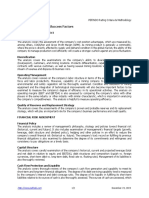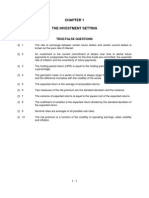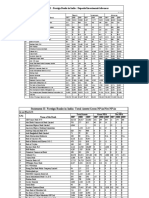Toll Road Industry - Key Success Factors: Business Risk Assessment Economy of Service Area
Toll Road Industry - Key Success Factors: Business Risk Assessment Economy of Service Area
Uploaded by
luqm4n99Copyright:
Available Formats
Toll Road Industry - Key Success Factors: Business Risk Assessment Economy of Service Area
Toll Road Industry - Key Success Factors: Business Risk Assessment Economy of Service Area
Uploaded by
luqm4n99Original Description:
Original Title
Copyright
Available Formats
Share this document
Did you find this document useful?
Is this content inappropriate?
Copyright:
Available Formats
Toll Road Industry - Key Success Factors: Business Risk Assessment Economy of Service Area
Toll Road Industry - Key Success Factors: Business Risk Assessment Economy of Service Area
Uploaded by
luqm4n99Copyright:
Available Formats
PEFINDO Rating Criteria & Methodology
Toll Road Industry - Key Success Factors
BUSINESS RISK ASSESSMENT
Economy of Service Area
The analysis covers the evaluations of the economic activities and potential in the areas served by the toll
road in order to better know the demand potential and sustainability. The analysis will also cover
observations on the quality and traffic volumes at the ordinary roads as the alternative roads. As the
concession is given by the government, it is very rare that a toll road operator competes directly to each
the other. Therefore, PEFINDO gives a credit to toll road operator that gets a toll concession with high
traffic potential. Toll roads are generally built to connect two or more cities or sub-urban areas and many
times are integrated with other strategic destination points such as harbor, airport, housing complexes and
etc to create traffic volumes. Therefore, other demographic factors such as numbers of population within
the areas of the toll, number of housing within the areas, number of alternative roads, economic condition,
business strengths in the cities surrounded by the toll, and etc. are also diligently reviewed during the
assessments to see the potential traffic growth.
Quality of Service
The analysis covers the examinations on the quality of toll road in an effort to generate more traffic
volumes. Poor quality of toll road could cause driving inconveniences or even make high accident rate, both
of which could lead to high maintenance costs and decrease in traffic volumes. The assessment on the
adequacy and conveniences of rest areas will also be included in the rating consideration, as those factors
are considered important to attract users of the toll. Reputation of the contractor that constructed the toll
road, number of bad accidents, safety of the roads and other company's efforts to enhance its quality of
toll road services are also reviewed during the rating assessments.
Cost and Operating Management
The analysis covers the assessments on the company's operating management in order to achieve the most
efficient costs, as none of toll operator has a control on the setting of toll tariffs. In Indonesia, tariffs for
toll roads are fully determined by the government. The management of the company's investment cost,
including construction, land acquisition and financing cost are also reviewed, as it will affect the magnitude
of depreciation cost as well as overall costs that has to be borne by the company for the entire life of the
toll operation. Although it often depends on the complexity of the toll, comparing construction cost per km
of toll road is always helpful to measure the efficiency. The analysis on operating margins (EBIT and
EBITDA) is also assessed by comparing the company’s ratios with other players in the same industry or
other industry with similar characteristic, which is important in analyzing the company’s competitiveness.
The analysis is helpful to measure operating efficiency. . If the toll road is already in operation, maintenance
cost will be the main cash cost for the toll road operator. Maintenance cost will always be related to the
quality of toll construction and the company's commitment on the quality of service.
Toll and Business Portfolio
The analysis covers the detailed reviews on the company's toll portfolio. A company with a larger toll
portfolio and varieties of demand characteristics is perceived to have more stable revenue stream as
compared to those that are dependent only on one toll road or on a number of toll roads with similar
characteristics. A company with toll roads located in many cities is expected to be able to minimize the
impact from any business deterioration due to economic slowdown in a certain city. During the crisis, it has
been shown that despite the currently-strong traffic volume, inner-city toll roads have been more sensitive
to political and economic fluctuation compared to inter-city ones. Although it is still insignificant, few toll
road operators have diversified their revenues to other related businesses such as advertisement, space
rental (rest area), management fee, and etc. The company's abilities and efforts to diversify its revenue
stream to other related businesses are also incorporated during the rating assessments.
http://www.pefindo.com 1/3 April 06, 2018
PEFINDO Rating Criteria & Methodology
FINANCIAL RISK ASSESSMENT
Financial Policy
The analysis includes a review of management's philosophy, strategy and policies toward financial risk
(historical, current and future). It also includes examination of management's financial targets (growth,
leverage, debt structure and dividend policy), hedging and other policies in an effort to reduce the
company's overall financial risk (historical vs. future). The company's track record on fulfilling its previous
financial obligations is also examined to determine the degree of its commitments and willingness and
consistency to pay obligations on a timely basis.
Capital Structure
The analysis covers careful examination of the company's historical, current and projected leverage (total
and net debt in relation to equity and EBITDA), debt structures and composition (rupiah vs. foreign
currencies, short-term debt vs. long-term debt, fixed rate vs. floating rate). Management of its liabilities is
also thoroughly reviewed.
Cash Flow Protection and Liquidity
The analysis covers thorough reviews of the company's cash flow generation and capability to meet its
short-term and long-term financial obligations. The degree of its debt-servicing capability level is measured
by the company's interest and debt coverage ratio. The degree of its liquidity in fulfilling its short-term
liabilities relative to its sources of cash is also thoroughly assessed. The sources of cash are assessed, which
include cash balance, estimated cash from operations, unused credit facilities, and other sources of cash.
The uses of cash other than short-term liabilities, such as capital expenditure, are also assessed.
Financial Flexibility
The analysis covers combined evaluations of all the financial measures above to arrive at an overall view
of the company's financial health. Analysis of other related factors or figures that are not specifically
examined above, such as insurance coverage, restrictive covenants in loan/bond agreements or parental
linkage and support, are also covered. Other analytical tasks covered are the evaluation of the company's
options under stress, including contingency plans and other capabilities and flexibility to deal with various
adverse scenarios. Shareholder support and commitment are also greatly considered.
http://www.pefindo.com 2/3 April 06, 2018
PEFINDO Rating Criteria & Methodology
DISCLAIMER
PT Pemeringkat Efek Indonesia (PEFINDO) does not guarantee the accuracy, completeness, timeliness or availability of the contents
of this report or publication. PEFINDO cannot be held liable for its use, its partial use, or its lack of use, in combination with other
products or used solely, nor can it be held responsible for the result of its use or lack of its use in any investment or other kind of
financial decision making on which this report or publication is based. In no event shall PEFINDO be held liable for any direct, indirect,
incidental, exemplary, compensatory, punitive, special or consequential damages, costs, expenses, legal fees, or losses including but
not limited to lost profits and opportunity costs in connection with any use of the contents of this report or publication. Credit analyses,
including ratings, and statements in this report or publication are statements of opinion as of the date they are expressed and not
statements of fact or recommendations to purchase, hold or sell any securities or to make any investment decision. The contents
cannot be a substitute for the skill, judgment and experience of its users, its management employees and/or clients in making
investment or other business decisions. PEFINDO also assumes no obligation to update the content following publication in any form.
PEFINDO does not act as fiduciary or an investment advisor. While PEFINDO has obtained information from sources it believes to be
reliable, PEFINDO does not perform an audit and does not undertake due diligence or independent verification of any information
used as the basis of and presented in this report or publication. PEFINDO keeps the activities of its analytical units separate from its
business units to preserve independence and objectivity of its analytical processes and products. As a result, certain units of PEFINDO
may have information that is not available to other units. PEFINDO has established policies and procedures to maintain the
confidentiality of certain non-public information received in connection with each analytical process. PEFINDO may receive
compensation for its ratings and other analytical work, normally from issuers of securities. PEFINDO reserves the right to disseminate
its opinions and analyses. PEFINDO’s public ratings and analyses are made available on its website, http://www.pefindo.com (free of
charge) and through other subscription-based services, and may be distributed through other means, including via PEFINDO
publications and third party redistributors. Information in PEFINDO’s website and its use fall under the restrictions and disclaimer
stated above. Reproduction of the content of this report, in full or in part, is subject to written approval from PEFINDO.
http://www.pefindo.com 3/3 April 06, 2018
You might also like
- No Objection Certificate. (NOC) - ZUDIO - Trent LimitedDocument2 pagesNo Objection Certificate. (NOC) - ZUDIO - Trent LimitedkomalbanbashiNo ratings yet
- Critical Succucess FactorDocument3 pagesCritical Succucess FactorHimansh SagarNo ratings yet
- Electricity Power Industry - Key Success Factors: Business Risk Assessment RegulationDocument2 pagesElectricity Power Industry - Key Success Factors: Business Risk Assessment Regulationanubhav saxenaNo ratings yet
- Manufacturing Bisnis N Finance RaiskDocument2 pagesManufacturing Bisnis N Finance RaiskFerlyan Huang 正莲No ratings yet
- Automotive Industry - Key Success Factors: Business Risk Assessment Market PositionDocument3 pagesAutomotive Industry - Key Success Factors: Business Risk Assessment Market PositionraghulNo ratings yet
- Mining Industry - Key Success Factors: Business Risk Assessment Cost PositionDocument2 pagesMining Industry - Key Success Factors: Business Risk Assessment Cost PositionJonas ArifinNo ratings yet
- Key Success Factors of The Pharmaceutical IndsustryDocument2 pagesKey Success Factors of The Pharmaceutical Indsustrybenj_morgan100% (1)
- Information Technology & IT Services IndustryDocument3 pagesInformation Technology & IT Services IndustryAlukwu JudeNo ratings yet
- BANKING INDUSTRY - Key Success Factors: Business Risk Assessment Market PositionDocument2 pagesBANKING INDUSTRY - Key Success Factors: Business Risk Assessment Market PositionGary YuthianNo ratings yet
- Key Success Facotr GeneralDocument3 pagesKey Success Facotr GeneralprashantNo ratings yet
- Retail IndustryDocument3 pagesRetail IndustryakavinashkillerNo ratings yet
- Financial RatiosDocument4 pagesFinancial RatiosDzul ArifNo ratings yet
- DMV ProjectsDocument27 pagesDMV Projectslingeshnandha4No ratings yet
- Tobacco Industry - Key Success Factors: Business Risk Assessment Market PositionDocument3 pagesTobacco Industry - Key Success Factors: Business Risk Assessment Market PositionGunadeep ReddyNo ratings yet
- Banking Industry - Key Success Factors: Business Risk Assessment Market PositionDocument2 pagesBanking Industry - Key Success Factors: Business Risk Assessment Market PositionrahidarzooNo ratings yet
- Objectives of Credit Rating: Financial Statements CreditworthinessDocument6 pagesObjectives of Credit Rating: Financial Statements CreditworthinessvishNo ratings yet
- Meaning of RatioDocument3 pagesMeaning of RatioVishnu VamshiNo ratings yet
- Special Financial Institution IndustryDocument2 pagesSpecial Financial Institution IndustryAVINASH KUMAR SINGHNo ratings yet
- Financial and Economic Analysis of A ProjectDocument32 pagesFinancial and Economic Analysis of A ProjectYohannes AlemuNo ratings yet
- Inam Afs Hum TVDocument3 pagesInam Afs Hum TVAadiMalikNo ratings yet
- Assignment On: Financial Statement Analysis and Valuation Course Code: (F-401)Document7 pagesAssignment On: Financial Statement Analysis and Valuation Course Code: (F-401)Md Ohidur RahmanNo ratings yet
- Research QuestionsDocument37 pagesResearch QuestionsAmmar HassanNo ratings yet
- New FmaDocument14 pagesNew FmaHahajahNo ratings yet
- 1ratio Analysis of Automobile Sector For InvestmentDocument29 pages1ratio Analysis of Automobile Sector For Investmentpranab_nandaNo ratings yet
- A Summer Training ReportDocument68 pagesA Summer Training ReportAvi Preet WaliaNo ratings yet
- QuestionsDocument2 pagesQuestionsJoe DicksonNo ratings yet
- Income Statement of Tata MotorsDocument101 pagesIncome Statement of Tata MotorsShashank GargNo ratings yet
- Purva Mam AssignmentDocument5 pagesPurva Mam AssignmentYuraj ChoudharyNo ratings yet
- NBFCs Sip 2020Document52 pagesNBFCs Sip 2020Prashant AgarkarNo ratings yet
- Research ProposalDocument19 pagesResearch Proposalዝምታ ተሻለNo ratings yet
- Working Capital FinancingDocument44 pagesWorking Capital FinancingShoib ButtNo ratings yet
- "Cash Flow Statement Analaysis" Manappuram Finance Limited: Master of Business AdministrationDocument12 pages"Cash Flow Statement Analaysis" Manappuram Finance Limited: Master of Business AdministrationGtnaidu VasuNo ratings yet
- Financial Statement Analysis - MadhuconDocument8 pagesFinancial Statement Analysis - Madhuconmohammed khayyumNo ratings yet
- An Introduction of Financial Statement AnlysisDocument14 pagesAn Introduction of Financial Statement AnlysisUpasana WadhwaniNo ratings yet
- Inbound 3187202134253747759Document9 pagesInbound 3187202134253747759Rodmar SumugatNo ratings yet
- Final SipDocument42 pagesFinal Siphsaurav06No ratings yet
- Company Performance Evaluation: Assessment and The Measurement of The Company Value, As The Ratio Between To Book-RatiosDocument5 pagesCompany Performance Evaluation: Assessment and The Measurement of The Company Value, As The Ratio Between To Book-RatiosSorina Mihaela PopescuNo ratings yet
- Capital Budgeting DefinitionDocument8 pagesCapital Budgeting DefinitionBharti AroraNo ratings yet
- Clipici EmiliaDocument4 pagesClipici Emiliamivamiva7No ratings yet
- Akanto VaiDocument19 pagesAkanto Vaiasaduzzaman192023No ratings yet
- Fitch - Rating Criteria For Infrastructure and Project Finance 2011Document32 pagesFitch - Rating Criteria For Infrastructure and Project Finance 2011dungvt5No ratings yet
- Mba ProjectDocument79 pagesMba ProjectMohanMahiNo ratings yet
- F. Understanding The Financial Statement and Its Components Sahid P.ADocument10 pagesF. Understanding The Financial Statement and Its Components Sahid P.Aantonette.escobia17No ratings yet
- 123Document11 pages123ranjitghosh684No ratings yet
- Banking Industry KSFDocument3 pagesBanking Industry KSFAdam AmruNo ratings yet
- Finincial StatementDocument4 pagesFinincial StatementZohor AbbasNo ratings yet
- Financial Ratio Analysis of Firms A ToolDocument6 pagesFinancial Ratio Analysis of Firms A ToolمريمالرئيسيNo ratings yet
- Chapter One 1.1 Background of The StudyDocument34 pagesChapter One 1.1 Background of The Studymubarek oumerNo ratings yet
- Tips On Project FinancingDocument3 pagesTips On Project FinancingRattinakumar SivaradjouNo ratings yet
- Chapter - 1 Introduction: 1.1 Background of The StudyDocument78 pagesChapter - 1 Introduction: 1.1 Background of The StudyPRIYA RANANo ratings yet
- Limitations of FSADocument22 pagesLimitations of FSANaval Chris0% (1)
- Ratio Analysis - FinanceDocument46 pagesRatio Analysis - FinancePragya ChauhanNo ratings yet
- SreeDocument105 pagesSreeAravind PothinaNo ratings yet
- Financial Statement Spreading - Pre Process ManualDocument2 pagesFinancial Statement Spreading - Pre Process ManualChandan Kumar ShawNo ratings yet
- S&P - Criteria - Corporates - General - Corporate Methodology - AsiaDocument47 pagesS&P - Criteria - Corporates - General - Corporate Methodology - Asiabrattanyu4171No ratings yet
- Limitations of Financial Statement AnalysisDocument5 pagesLimitations of Financial Statement AnalysisJemilyn Cervantes-Segundo0% (2)
- Financial Ratio Interpretation (ITC)Document12 pagesFinancial Ratio Interpretation (ITC)Gorantla SindhujaNo ratings yet
- Ratio Analysis PDFDocument3 pagesRatio Analysis PDFABINASHNo ratings yet
- Black BookDocument136 pagesBlack BookDeepak YadavNo ratings yet
- Ratio - Analysis - Green - Park Project Report1Document99 pagesRatio - Analysis - Green - Park Project Report1Raju AmmuNo ratings yet
- Finance for Nonfinancial Managers: A Guide to Finance and Accounting Principles for Nonfinancial ManagersFrom EverandFinance for Nonfinancial Managers: A Guide to Finance and Accounting Principles for Nonfinancial ManagersNo ratings yet
- Chapter 9: Wholesaling and Physical DistributionDocument3 pagesChapter 9: Wholesaling and Physical DistributionReid Aileen Ivorie Villalobos100% (1)
- Day Old Chicken Rearing Business PlanDocument9 pagesDay Old Chicken Rearing Business PlanshmekebeNo ratings yet
- 1540025975585V2Aln72X00W6W7Sg PDFDocument3 pages1540025975585V2Aln72X00W6W7Sg PDFMehul GajjarNo ratings yet
- Diguskq JbkjbaDocument13 pagesDiguskq JbkjbaAdityaNo ratings yet
- Working Capital, Credit and Accounts Receivable ManagementDocument31 pagesWorking Capital, Credit and Accounts Receivable ManagementAnkit Agarwal100% (1)
- Costing For Civil Engineering ProjectDocument26 pagesCosting For Civil Engineering ProjectArchangelmc50% (2)
- SKMSDocument12 pagesSKMSuserdz7770No ratings yet
- Niantic v. Global++ - Mot. For PIDocument28 pagesNiantic v. Global++ - Mot. For PIGrahamNo ratings yet
- Twisting Servicescapes: Diversion of The Physical Environment in A Re-Appropriation ProcessDocument16 pagesTwisting Servicescapes: Diversion of The Physical Environment in A Re-Appropriation ProcessHCGSJNo ratings yet
- ACCOUNTABILITY, TRANSPARENCY, FAIRNESS and INTEGRITYDocument5 pagesACCOUNTABILITY, TRANSPARENCY, FAIRNESS and INTEGRITYMonina VillaNo ratings yet
- Digests Pubcorp CasesDocument205 pagesDigests Pubcorp CasesRbee C. AblanNo ratings yet
- Kajaria CSRDocument5 pagesKajaria CSRASHISH BHATNo ratings yet
- MKT 103 Syllabus PDFDocument4 pagesMKT 103 Syllabus PDFIvanNo ratings yet
- The Investment Setting: True/False QuestionsDocument14 pagesThe Investment Setting: True/False Questionsjigglebots4695No ratings yet
- Organizing A Startup FactoryDocument15 pagesOrganizing A Startup FactoryMinas Marios KontisNo ratings yet
- Statement I: Foreign Banks in India: Deposits/Investments/AdvancesDocument8 pagesStatement I: Foreign Banks in India: Deposits/Investments/Advancesramkumar6388No ratings yet
- 2018 Integrated Report PDFDocument290 pages2018 Integrated Report PDFAndrea PalancaNo ratings yet
- Prequalified Final 2015-2017Document34 pagesPrequalified Final 2015-2017susan akellooNo ratings yet
- Checklist For Company RegistrationDocument8 pagesChecklist For Company RegistrationshrikantmsdNo ratings yet
- Business Continuity ManagementDocument3 pagesBusiness Continuity ManagementlavetiNo ratings yet
- TF26Document2 pagesTF26Gohar Muhammad KhanNo ratings yet
- Marketing Strategies: Introductory Session MBA Sem 4 9718504207 Ssaha1@amity - EduDocument10 pagesMarketing Strategies: Introductory Session MBA Sem 4 9718504207 Ssaha1@amity - EduSIDHARTH GUPTANo ratings yet
- Qatar Review Q1 2016 enDocument6 pagesQatar Review Q1 2016 enahmedh_98No ratings yet
- RPOChallenges and OpportunitiesDocument27 pagesRPOChallenges and Opportunitiestresci_teddy01No ratings yet
- Brand Preferrence of Packaged MilkDocument73 pagesBrand Preferrence of Packaged MilkSUKUMAR82% (17)
- Partha Mandayam Page 1 of 4Document4 pagesPartha Mandayam Page 1 of 4Jacob BassNo ratings yet
- Booking #2923207948Document2 pagesBooking #2923207948olyNo ratings yet
- Inventory CycleDocument38 pagesInventory CycleSarah Laras WitaNo ratings yet
























































































